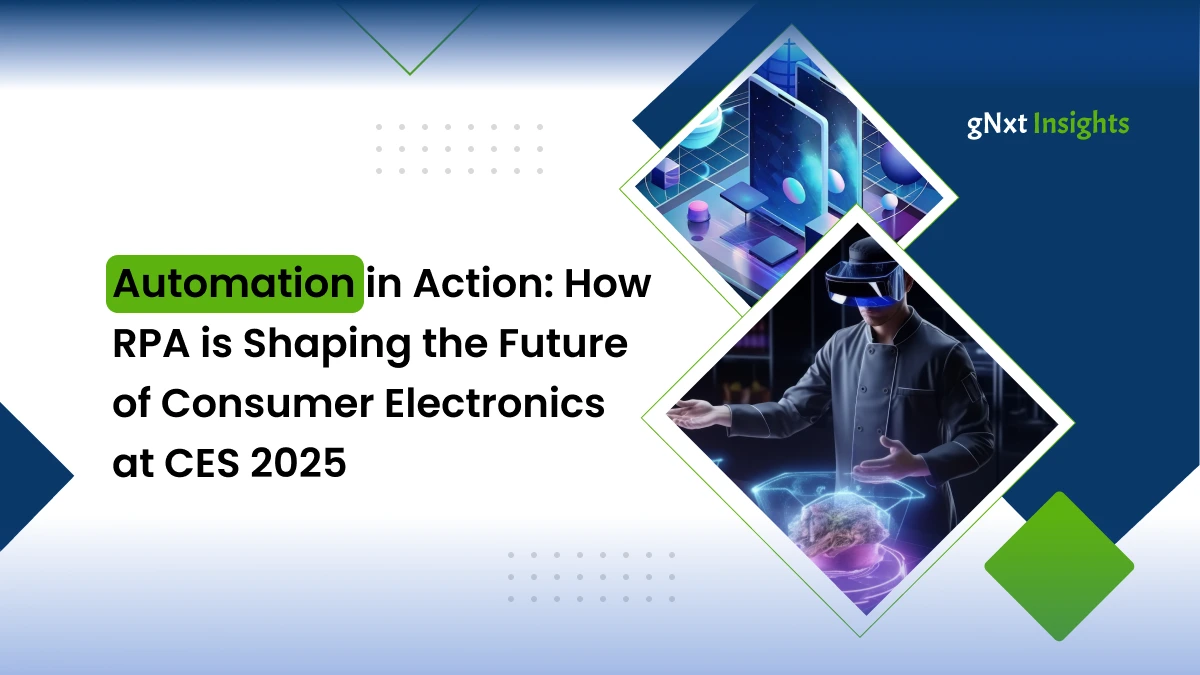- December 30, 2024
- by Anoop Kumar
As CES 2025 takes center stage in Las Vegas, it brings with it the latest innovations redefining the consumer electronics industry. From cutting-edge IoT devices to the next wave of AI-powered gadgets, CES is the global stage where technology meets possibility. Amid the buzz of futuristic product launches, one critical enabler of this innovation is making waves behind the scenes: Robotic Process Automation (RPA).
RPA, a cornerstone of digital transformation, is silently yet profoundly revolutionizing the consumer electronics sector. From streamlining operations to enhancing customer experience, RPA is powering the industry’s growth and preparing it for the challenges of tomorrow. At CES 2025, RPA takes the spotlight as the backbone of operational excellence and innovation. Let’s dive into how RPA is shaping the future of consumer electronics and why it’s a key theme at this year’s event.
Robotic Process Automation(RPA) in Consumer Electronics
Consumer electronics is a fast-paced industry driven by rapid innovation, global supply chains, and ever-evolving customer demands. To stay competitive, companies must manage complexity with agility and precision. Enter RPA—a technology designed to automate repetitive, time-consuming tasks, freeing up human capital for more strategic initiatives.
Key applications of RPA in consumer electronics include:
- Supply Chain Optimization: Automating inventory management, order processing, and supplier communications to reduce delays and errors.
- Quality Assurance: Streamlining defect detection and compliance reporting during manufacturing processes.
- Customer Support: Enhancing customer service through automated ticket resolution, chatbot integration, and real-time updates on product repairs or deliveries.
- Warranty and Claims Management: Reducing the time and effort required to process warranty claims and ensuring faster resolutions for end consumers.
- Regulatory Compliance: Automating compliance tracking to meet global regulations, reducing the risk of penalties and recalls.
At CES 2025, these applications take center stage as industry leaders showcase how RPA is not just a tool but a transformative force.
RPA and Innovation at CES 2025
This year, CES highlights the convergence of technologies such as IoT, AI, and RPA to drive smarter, more connected consumer electronics. Here are some of the ways RPA is enabling innovation:
1. Accelerating the Smart Home Revolution
The smart home market is booming, with CES 2025 presenting groundbreaking devices that integrate seamlessly into consumers’ lives. RPA supports this revolution by automating the development, testing, and deployment of IoT devices. For example, RPA bots can simulate user interactions to test device functionality, ensuring products are market-ready faster than ever.
2. Enabling Personalization at Scale
Personalized consumer experiences are no longer a luxury but a necessity. RPA empowers electronics manufacturers to analyze vast amounts of customer data, identifying trends and preferences in real time. This data drives product customization, marketing campaigns, and after-sales services, ensuring a tailored experience for every customer.
3. Enhancing Sustainability Initiatives
Sustainability is a major theme at CES 2025, and RPA is playing a critical role in helping companies meet their environmental goals. From tracking carbon footprints in supply chains to optimizing waste management in manufacturing, RPA enables the industry to align with global sustainability standards.
4. Improving Time-to-Market
In a competitive industry, speed is everything. RPA reduces bottlenecks in the product lifecycle, from design to distribution. By automating tasks like product testing, compliance checks, and supplier coordination, companies can bring their innovations to market faster.
Real-World Impact: Success Stories of RPA in Consumer Electronics
Samsung: Scaling Production with RPA
A global leader in consumer electronics, Samsung has embraced RPA to streamline its production lines. By automating repetitive tasks such as inventory tracking and quality inspections, the company has significantly reduced production delays and improved overall efficiency.
Sony: Enhancing Customer Support
Sony leverages RPA to automate customer service processes, including warranty claims and repair tracking. This has resulted in faster response times and higher customer satisfaction, giving Sony a competitive edge in the market.
LG: Driving Sustainability with Automation
LG has implemented RPA to monitor and reduce waste across its supply chain. By automating data collection and analysis, the company has made strides in meeting its sustainability targets, a key focus at CES 2025.
Why CES 2025 is the Perfect Stage for RPA
CES has always been a platform for showcasing transformative technologies. In 2025, the spotlight is not just on the products but also on the processes that make these innovations possible. RPA’s ability to enhance efficiency, reduce costs, and drive innovation makes it a key enabler of the technologies unveiled at CES.
For businesses attending CES 2025, the message is clear: RPA is not optional—it’s essential. Whether you’re a startup innovating in smart devices or an established player in the IoT ecosystem, integrating RPA into your operations can unlock unprecedented value.
Looking Ahead: The Future of RPA in Consumer Electronics
As we look beyond CES 2025, the role of RPA in consumer electronics will only grow. With advancements in AI and machine learning, RPA will become more intelligent, capable of handling complex tasks and driving deeper insights. This evolution will further solidify its position as a cornerstone of the industry.
For organizations in the consumer electronics space, the time to act is now. Embracing RPA not only ensures you remain competitive but also positions you as a leader in innovation and operational excellence.
Conclusion
CES 2025 is a testament to the incredible strides being made in the consumer electronics industry. As groundbreaking devices and technologies capture global attention, it’s important to recognize the critical role of RPA in enabling these innovations. From streamlining operations to driving sustainability, RPA is the silent force propelling the industry forward.
As the curtain rises on CES 2025, one thing is clear: the future of consumer electronics is automated. And with RPA leading the charge, the possibilities are limitless.
Key Takeaways:
- RPA is a transformative force in the consumer electronics industry, driving efficiency, innovation, and sustainability.
- At CES 2025, RPA enables companies to showcase smarter, faster, and more personalized products.
- Industry leaders like Samsung, Sony, and LG are already leveraging RPA to gain a competitive edge.
- The integration of RPA with AI and IoT will shape the future of consumer electronics beyond CES 2025.
About Author

CEO at gNxt Systems
With 25+ years of expertise, Mr. Anoop Jain delivers complex projects, driving innovation through IT strategies and inspiring teams to achieve milestones in a competitive, technology-driven landscape.

